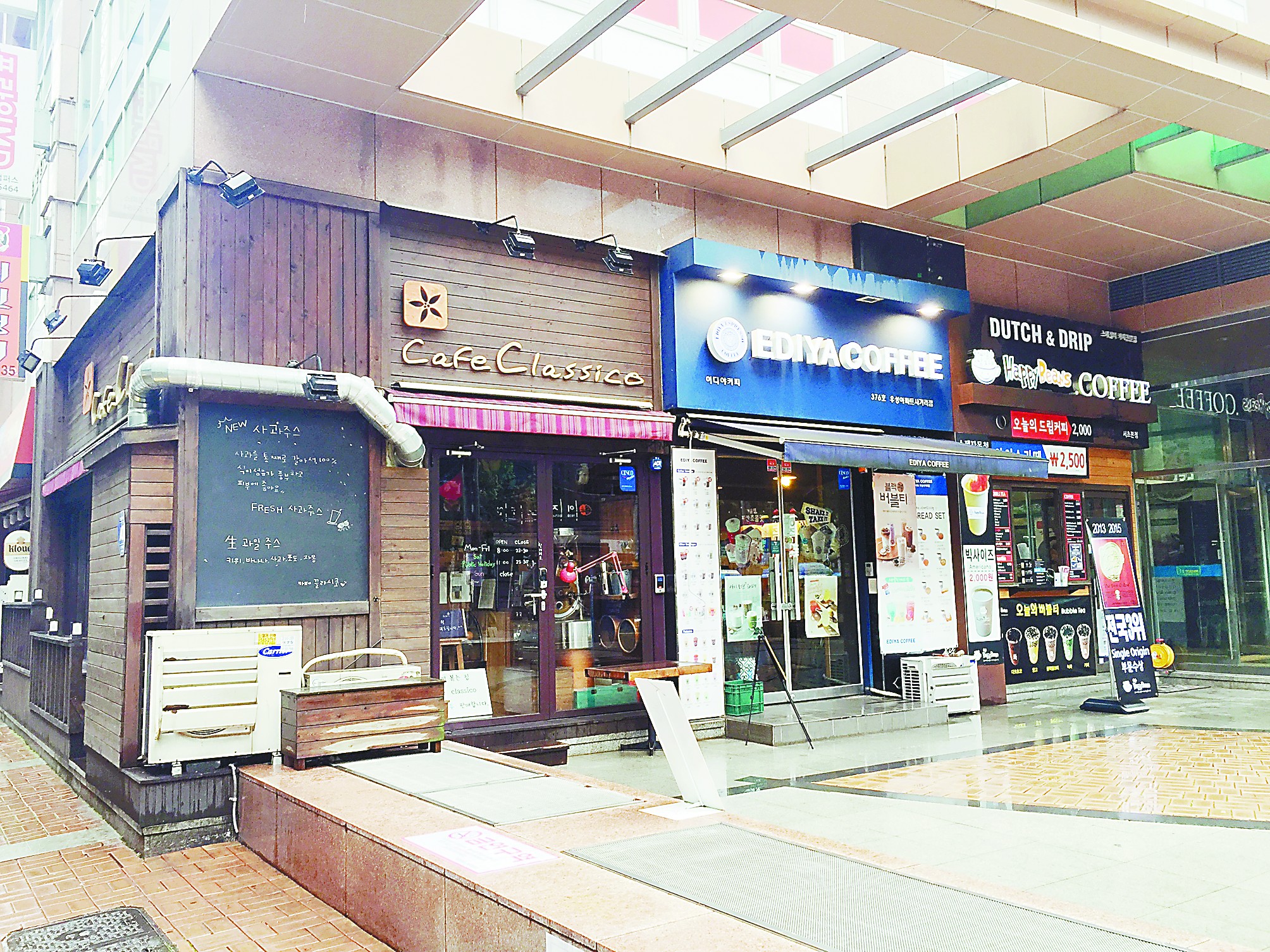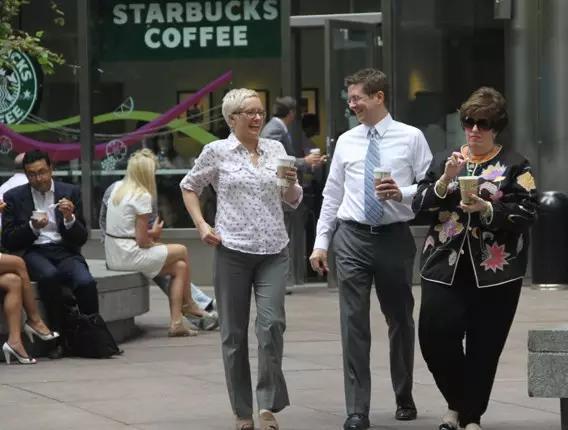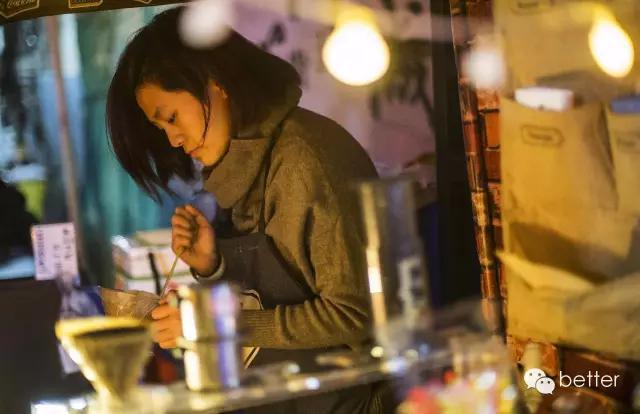South Koreans are poisoned by coffee.
[Cui Jietong, special correspondent of the Global Times to South Korea] "Cui, look!" Looking along the fingers of Zhu Shenghe, a reporter from South Korea's East Asia Daily, the reporter saw that the three coffee shops were close to each other (pictured), and the lights reflected the rainy night. "there are so many coffee shops that we are all poisoned!" He said.

The place where we stood was a small square on the street corner near the Gangnam City Plaza Hotel in Ruicao District, Seoul. Walking down the streets of Seoul, you will find at least one coffee shop if you look around. Coffee has overtaken kimchi, South Korea's national dish, to become the country's most consumed food, according to a 2014 survey published by the International Business Times. On average, Koreans drink coffee 12.2 times a week. Kimchi, which has been a Korean food since the 16th century, eats an average of 11.9 times a week, while rice eats 6.9 times a week.
"if you stay in Seoul for a few more days, you will find that when you have lunch together, colleagues in the company basically don't talk to each other. After lunch, they get up and leave without saying a word, and then go straight to the coffee shop. That is where they chat and talk about things. This is a tacit understanding and a habit." "I didn't drink coffee when I first came to Seoul a few years ago," Li Meilian, who is studying in Seoul, told the Global Times. "I watched others drink it, but you can't blend in without coffee. Now I'm drinking it, too."
Coffee was first introduced into South Korea in the late 19th century and became popular during Japan's colonial rule of the Korean Peninsula. During the Korean War in the 1950s, American soldiers brought instant coffee to South Korea, making it more popular. But cafes have blossomed everywhere to form a culture that has only happened in the last 20 years. Starbucks, an American coffee chain, opened its first store in Seoul in 1999 at South Korea's prestigious Lihua Women's University, and by 2014 it had nearly 300 stores. Daniel Schwickendik, a professor at Seung Kwan University in South Korea, commented, "walking down the street with a Starbucks paper cup has become a status symbol, like a designer bag on your arm." Coffee has become an indicator of class status in South Korea, so much so that there is a cultural phenomenon of "bean paste girl" in South Korea. "bean paste girl" refers to a girl who chooses not to eat meat in order to save money for luxury goods. Because bean paste is a very cheap food in Korea. In the 2012 Korean divine song "Gangnam style", the singer sang sarcastically: where is a beautiful girl who knows how to enjoy a cup of coffee?
"want to live in Seoul? there are 13 things you have to get used to." On the list on the seoulistic website, which promotes and promotes Seoul to foreigners, coffee shops rank before kimchi, metal chopsticks, soju, sitting on the ground and bowing, even though the latter has long been remembered as a symbol of South Korea. In fact, South Korea has incorporated coffee into its culture. Cafes can be seen everywhere in many familiar Korean dramas, and some Korean coffee chains have taken advantage of the "Korean Wave" to open stores in Paris, New York, Beijing and other parts of the world. It is understood that there are 284 Starbucks stores in Seoul, ranking first in the world, which dwarfs New York in the United States. No one knows how long South Korea's "coffee mania" will last. Under the fierce market competition, many Korean coffee shop owners begin to choose the low-price strategy, and the market struggle is becoming increasingly fierce.
Source: global Times
Important Notice :
前街咖啡 FrontStreet Coffee has moved to new addredd:
FrontStreet Coffee Address: 315,Donghua East Road,GuangZhou
Tel:020 38364473
- Prev

Six tips for saving money by drinking Starbucks
Talking about a coffee shop with a sunny afternoon, leaning against a comfortable chair, enjoying a cup of coffee at hand, spending time in a room filled with the smell of fresh coffee beans, talking about Starbucks also having a sunny afternoon after lunch, holding a cup of coffee under the office building, enjoying buying Starbucks in a noisy queue, walking handsome on the road for white-collar workers who pay for Starbucks every day.
- Next

Across the cedar road full of gears, the lonely man had a cup of coffee
This society is like a perpetual motion machine, and we are all just one of the gears. The winter cedar road does not have the hustle and bustle of summer. At 08:30 in the evening, only a few diners of Bali lobster ate midnight snacks. The glasses Restaurant next door ended its busy dinner, and the messengers and cooks played with their cell phones in the kitchen. Between the two restaurants is a residential aisle about five meters wide, filled with stewed meat and simmering.
Related
- Being chased out of the rain in front of Starbucks?! Store: Sheltering from rain under umbrellas poses a safety hazard
- The white moonlight has changed?! Lucky launches "Big Winter Pear American"
- Hand-brewed coffee three-stage method, high-sweet and universal brewing method to share! What does the high sweet water level of hand-brewed coffee mean?
- What is the difference between raw, refined and full espresso coffee? How to extract espresso and taste good?
- A complete list of coffee bean names and their meanings! What is Yejia Shefi coffee? Where is Mantelin coffee?
- What grade does Arida Manor Kaduai coffee beans belong to? What treatment is Arida ASD slow anaerobic sun exposure?
- The milk tea cup becomes smaller?! Overlord Tea Girl launches a new "Return to Yunnan" series
- Accused of selling counterfeit and high-priced coffee beans! Well-known boutique coffee brand "Oukelao" bowed and apologized!
- How to make espresso dumplings? Can I eat coffee and glutinous rice balls together?
- Save the unformed and stagnant powder cakes in one second! What is the problem with stagnant water in the powder bowl of the espresso machine?

